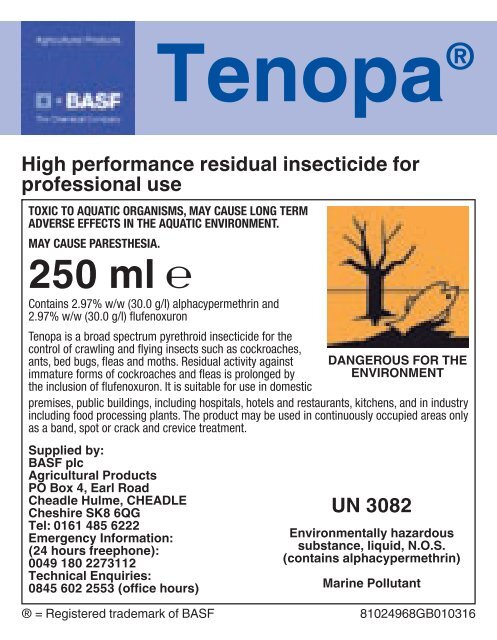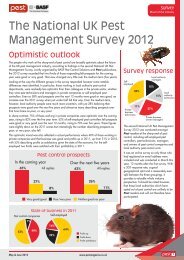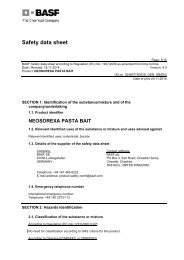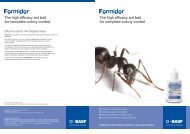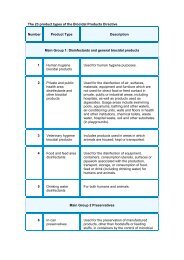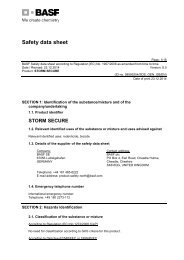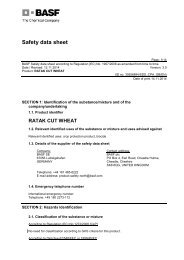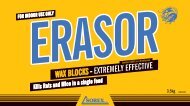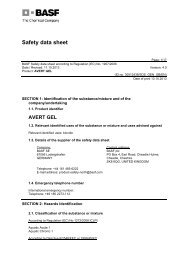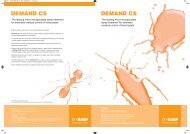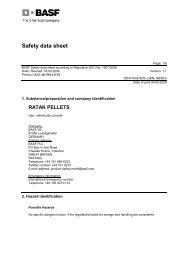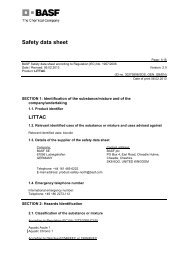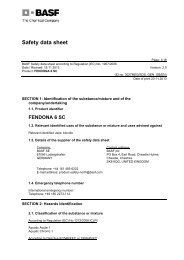Tenopa - Pest Control Management - BASF
Tenopa - Pest Control Management - BASF
Tenopa - Pest Control Management - BASF
- No tags were found...
You also want an ePaper? Increase the reach of your titles
YUMPU automatically turns print PDFs into web optimized ePapers that Google loves.
Tenopa ®High performance residual insecticide forprofessional useTOXIC TO AQUATIC ORGANISMS, MAY CAUSE LONG TERMADVERSE EFFECTS IN THE AQUATIC ENVIRONMENT.MAY CAUSE PARESTHESIA.250 ml ℮Contains 2.97% w/w (30.0 g/l) alphacypermethrin and2.97% w/w (30.0 g/l) flufenoxuronTenopa is a broad spectrum pyrethroid insecticide for thecontrol of crawling and flying insects such as cockroaches,ants, bed bugs, fleas and moths. Residual activity againstimmature forms of cockroaches and fleas is prolonged bythe inclusion of flufenoxuron. It is suitable for use in domesticSupplied by:<strong>BASF</strong> plcAgricultural ProductsPO Box 4, Earl RoadCheadle Hulme, CHEADLECheshire SK8 6QGTel: 0161 485 6222Emergency Information:(24 hours freephone):0049 180 2273112Technical Enquiries:0845 602 2553 (office hours)DANGEROUS FOR THEENVIRONMENTpremises, public buildings, including hospitals, hotels and restaurants, kitchens, and in industryincluding food processing plants. The product may be used in continuously occupied areas onlyas a band, spot or crack and crevice treatment.UN 3082Environmentally hazardoussubstance, liquid, N.O.S.(contains alphacypermethrin)Marine Pollutant® = Registered trademark of <strong>BASF</strong> 81024968GB010316
Tenopa ®STATUTORY CONDITIONS RELATING TO USEFOR USE ONLY AS AN INSECTICIDENormal rate: dilute 25 ml concentrate in 5 litres of water,apply to 100 m 2 .Special rate: dilute 50 ml concentrate in 5 litres of water,apply to 100 m 2 .To be applied as a coarse spray only at low pressureThe (COSHH) <strong>Control</strong> of Substances Hazardous to HealthRegulations 1999 may apply to the use of this product atwork.FOR USE ONLY BY PROFESSIONAL OPERATORS.Engineering control of operator exposure must be usedwhere reasonably practicable in addition to the followingitems of personal protective equipment:Wear suitable protective clothing, gloves and eye/faceprotection.AVOID EXCESSIVE CONTAMINATION OF COVERALLSAND LAUNDER REGULARLY.DO NOT BREATHE SPRAY. Otherwise wear respiratoryprotective equipment and eye protection (See HSEGuidance Booklet HS (G) 53:. “The Specification, Useand Maintenance of Respiratory Protective Equipment - APractical Guide.”However, engineering controls may replace personalprotective equipment if a COSHH assessment shows thatthey provide an equal or higher standard of protection.COVER FOOD, FOOD PREPARING EQUIPMENT ANDEATING UTENSILS before application.COVER WATER STORAGE TANKS before application.DO NOT APPLY TO SURFACES on which food or feed isstored, prepared or eaten.DO NOT APPLY TO CLOTHING OR BEDDING.UNPROTECTED PERSONS AND ANIMALS SHOULD BEKEPT AWAY FROM TREATED AREAS UNTIL SURFACESARE DRY.Do not contaminate ground, waterbodies or watercourseswith chemicals or used container.REMOVE OR COVER FISH TANKS AND BOWLS beforeapplication.Do not empty into drains.DO NOT USE NEAR DRAINS, PREVENT ANY SURFACERUN-OFF FROM ENTERING DRAINS.DO NOT APPLY DIRECTLY TO ANIMALS.HAZARDOUS TO BEES.THIS MATERIAL AND ITS CONTAINER must be disposedof in a safe way.Avoid contact with skin.READ ALL PRECAUTIONS BEFORE USE. HSE 6206® = Registered trademark of <strong>BASF</strong> 81032321GB0028
DIRECTIONS FOR USEApply using any conventional manual orpower sprayer equipped to produce acoarse spray. Add the appropriate volumeof Tenopa to the required volume ofclean water and agitate. If a delay occursbetween treatments, re-agitate beforere-use. Apply to just before run-off, using1 litre per 20 m 2 , to surfaces frequentedby pests, especially cracks, crevices andbehind furnishings and equipment.The Normal rate is for the routinetreatment of crawling and flying pests; use25 ml per 5 litres and apply to 100 m 2 .The Special rate is for use where rapidinitial control is required and/or surfacesare dirty or highly absorbent; use 50 ml per5 litres and apply to 100 m 2 .PRECAUTIONSWASH ANY CONTAMINATION from skinor eyes immediately.WASH HANDS AND EXPOSED SKINbefore meals and after use.DO NOT HANDLE TREATED FABRICSUNTIL DRY AND AIR THOROUGHLYBEFORE USE.KEEP IN A SAFE PLACE.Use appropriate containment to avoidenvironmental contamination.Keep only in original container.Keep container tightly closed.
FIRST AIDRemove contaminated clothingimmediately and wash contaminated skinthoroughly with soap and water. In cases ofeye splashes, flush eyes immediately withplenty of clean water and obtain medicalattention. In cases of severe skin exposuretypical sensations of the exposed skin,especially the face and other areas oftender skin, may appear. These may betingling, burning or numbness. Thesesensations will wear off in a few hours. Ifother symptoms should occur refer to adoctor or the nearest hospital, show thelabel.MEDICAL ADVICEContains a pyrethroid insecticide andan acylurea insecticide. This product isof low toxicity by oral and dermal routes.Poisoning is unlikely to occur. Treatsymptomatically. For further advice contactthe Poisons Reference Centre.This product is approved under The<strong>Control</strong> Of <strong>Pest</strong>icides Regulations 1986 foruse as directed.HSE 6206Slacken dispenser chamber top. Squeezebottle to fill chamber to required volume.Open and pour. After dispensing closetops tightly.Tenopa is an approved <strong>BASF</strong> product.<strong>BASF</strong> plc, P O Box 4, Earl Road, CheadleHulme, Cheadle, Cheshire SK8 6QGTelephone: 0161-485 6222
Section 6 of the Health and Safety at Work ActAdditional Product Safety InformationThe product label provides information on a specificpesticidal use of the product; do not use otherwise,unless you have assessed any potential hazardinvolved, the safety measures required and thatthe particular use has “off-label” approval or isotherwise permitted under the <strong>Control</strong> of <strong>Pest</strong>icidesRegulations.The information on this label is based on the bestavailable information including data from testresults1. SUBSTANCE/PREPARATION AND COMPANYNAMEProduct Name: TENOPAHSE Number: 6206Company:<strong>BASF</strong> plcPO Box 4, Earl RoadCheadle Hulme, CheadleCheshire SK8 6QGTel: 0161 485 6222Fax: 0161 486 0891Emergency information: 0049 180 2273112(24 hours freephone)2. COMPOSITION/INFORMATION ON INGREDIENTSUse: ONLY AS AN INSECTICIDEFormulation: 2.97% w/w (30 g/l)alphacypermethrin + 2.97% w/w(30 g/l) flufenoxuron.Hazardous CAS No. g/l Symbol R PhrasesingredientsAlphacypermethrin 67375-30-8 30 T (Toxic) R20, R25,R37,R48/22,(2.97% N (Dangerous R50/53w/w) for theenvironment)30 N (Dangerous R50/53Flufenoxuron 101463-69-8(2.97% for thew/w) environment)Tributyl phenol 9046-09-7 Xn (Harmful) R22, R41,R51/53polyglycol ether N (Dangerous0.2%(w/w) for theenvironment
3. HAZARDS IDENTIFICATIONDANGEROUS FOR THE ENVIRONMENTTOXIC TO AQUATIC ORGANISMS, MAY CAUSELONG TERM ADVERSE EFFECTS IN THE AQUATICENVIRONMENT (R51/53).MAY CAUSE PARESTHESIA.4. FIRST AID MEASURESGeneral advice: If a person thinks that they havebeen exposed to this product and feels unwell,call a doctor or take them to a hospital. Removeall contaminated clothing. Keep them at RESTaway from source of contamination. DO NOTALLOW smoking or eating. First aider shouldavoid becoming contaminated and wear protectiveclothing if necessary.Eye contact: Immediately irrigate affected eyesfor at least 15 minutes under flowing water, witheyelids open.Skin contact: Immediately remove contaminatedclothing and footwear and flush skin with plenty ofwater. Wash affected area thoroughly with soap andwater as soon as possible.Ingestion: DO NOT INDUCE VOMITING. Wash outmouth with clean water. Seek medical attentionimmediately.Inhalation: Keep person calm, remove to fresh air.Unconsciousness: If danger of loss of consciousness,place person in recovery position. Apply artificialventilation if necessary, but care must be taken toavoid contamination of the first aider.GUIDE TO PHYSICIAN – general adviceActive ingredient group: Alphacypermethrin– pyrethroidFlufenoxuron -benzoylurea.Toxic effects: This material is of low generaltoxicity.
Symptoms of accidental over exposure: Pyrethroidsmay cause abnormal numbness or tingling to theskin (paresthesia).Severe exposure may cause acute neurotoxicityincluding seizures, and other signs and symptomssuch as muscle fasciculations and those ofpulmonary edema.Any unusual symptoms which occur after exposure(by any mode of entry) should be recorded andreported to <strong>BASF</strong> at Cheadle.(i) Treatment should be symptomatic andsupportive based on judgement of physician.(ii) If the product has been swallowed, gastriclavage with proper laryngeal control may benecessary. For ingestion of small quantitiesactivated charcoal as an absorbent in adosage of 30 grams in 100 ml of water may beconsidered.(iii) Maintenance of ventilation and oxygen therapyto be used as required.(iv) If symptomatic therapy is indicated for controlof restlessness, anxiety or convulsions, thenDiazepam is recommended as the drug ofchoice.5. FIRE FIGHTING MEASURESSuitable extinguishing media: Water spray, waterfog,foam and carbon dioxide, dry extinguishingmedia.Possible harmful fumes in a fire: Carbon monoxide,hydrogen chloride, hydrogen cyanide, nitrogenoxides, organochloric compounds, sulfur oxides.Protective equipment: Self-contained breathingapparatus and protective clothing.Further information: Call the Fire Brigade at onceto deal with all fires involving pesticides unless thefire is small and immediately controllable. Sprayunopened containers with a mist spray to keepcool. If without risk, remove intact containersfrom exposure to fire. Contain fire-fighting water,bunding if necessary with sand or earth. Do not
allow contamination of public drains or surfaceor ground waters. Dispose of fire debris andcontaminated water as advised in the MAFF/HSE“<strong>Pest</strong>icides: Code of Practice for the Safe Use of<strong>Pest</strong>icides on Farms and Holdings”.6. ACCIDENTAL RELEASE MEASURESIf spilled: Wear prescribed protective clothing. Clearspillage immediately. Contain spillage and absorbonto earth, sand or suitable absorbent material.Collect contaminated material and place in amarked container for disposal. Thoroughly washarea of spillage. Dispose of contaminated materialsas advised in the MAFF/HSE “<strong>Pest</strong>icides: Code ofPractice for the Safe Use of <strong>Pest</strong>icides on Farms andHoldings”.Wash thoroughly immediately after handlingspillages, or at once if contaminated.Personal protective equipment: See Section 8.Environmental precautions: Do not allowcontamination of public drains or surface or groundwaters. Inform local water plc if spillage entersdrains and the Environment Agency (England &Wales), the Scottish Environmental ProtectionAgency (Scotland), or the Environment and HeritageService (Northern Ireland) if it enters surface orground waters. Keep people and animals away.7. HANDLING AND STORAGEHandling: Do not breathe vapour/mist. Avoid contactwith skin and eyes. When using do not eat, drink orsmoke.Protection against fire and explosion: Product is noncombustible.No special precautions necessary.Storage: Store separately from food, drink andanimal feed.Keep dry and frostproof in a suitable pesticidestore.Keep away from sources of ignition and protect fromexposure to fire.Keep away from heat and direct sunlight. Protectfrom temperatures below -10°C and above 40 °C.
8. EXPOSURE CONTROLS AND PERSONALPROTECTION(i)PRECAUTIONS (from product label)WASH ANY CONTAMINATION from skin or eyesimmediately.WASH HANDS AND EXPOSED SKIN beforemeals and after use.DO NOT HANDLE TREATED FABRICS UNTIL DRYAND AIR THOROUGHLY BEFORE USE.KEEP IN A SAFE PLACE.Use appropriate containment to avoidenvironmental contamination.Keep only in original container.Keep container tightly closed.(ii) PERSONAL PROTECTIVE EQUIPMENTIn tests with a range of pesticide products,protective gloves made of nitrile rubber at least0.5 mm thick and 300 mm long have beenfound to be the most suitable. Gloves madeof viton, butyl rubber, neoprene and PVC canalso offer good protection. Gloves must protectthe whole hand and wrist and repeated useof these gloves depends upon spillages beingwashed off immediately. The gloves shouldbe thoroughly washed after each operation.Face shields should conform to BS EN 166.Respirators should conform to BS EN 149, filtertype P2.The wearing of other personal protectiveequipment may be required to supplement theitems listed above. These are described in theMAFF/HSE “<strong>Pest</strong>icides: Code of Practice for theSafe Use of <strong>Pest</strong>icides on Farms and Holdings”.Decontaminate all personal protectiveequipment after use. When this is not possibledispose of as contaminated wastes.
(iii) OCCUPATIONAL EXPOSURE LIMITS (OESs)Hazardous ingredients Long term exposure limit(8 hour TWA referenceperiod)Propylene glycol (Propane-1,2-diol)Vapour & particulates(total) 150 ppm / 474 mg.m –3Particulates 10 mg.m –39. PHYSICAL AND CHEMICAL PROPERTIESForm:Flowable liquidColour:WhiteDensity: ~1.03 g cm 3 @ 20 °CSolubility in water: Disperses in waterpH value:6-8 (20°C) undilutedFlash point: Non-flammableViscosity:80-120 mPa.s(dynamic) (20°C, 100 1/1)10. STABILITY AND REACTIVITYHazardous reactions: None provided product iscorrectly stored and handled.Substances to avoid: Strong alkalis.Corrosive to mild steel, tin.Hazardous decomposition products: None providedproduct is correctly stored and handled.11. TOXICOLOGICAL INFORMATIONAcute toxicity:Ingestion: Low toxicity(LD 50 oral (rat): 4296 mg/kg bw)Skin contact: Non-irritant(LD 50 dermal (rat): > 2000 mg/kg bw)Inhalation: Unlikely to cause a problem(LC 50 inhalation (rat) 4 h: > 2.37 mg/l)Eye contact: Non-irritantSensitising potential: No sensitising potential
12. ECOLOGICAL INFORMATIONInformation for the active substance alphacypermethrin.Fathead minnow (P. promelor) 0.93 ug/lPseudokirchneriella subcapitataEC 50 (96 h): > 0.1 mg/lDaphnia magnaLC 50 (48 h): 0.0003 mg/lInformation for the active substanceflufenoxuron:Rainbow trout (O. mykiss) LC 50, 96h,>0.0049 mg/LS. capricornutum EC50, >0.004 mg/LDaphnia magna EC50, 48h, 0.00004 mg/L13. DISPOSAL CONSIDERATIONSLeaking containers: Damaged or leaking containersmust be dealt with as soon as noticed by sealingthem in impermeable containers.Disposal of used containers: Follow the directionsgiven in the MAFF/HSE “<strong>Pest</strong>icides: Code of Practicefor the Safe Use of <strong>Pest</strong>icides on Farms andHoldings”.Disposal of diluted pesticide: Advice for the disposalor re-use of diluted pesticide is given in the MAFF/HSE “<strong>Pest</strong>icides: Code of Practice for the Safe Use of<strong>Pest</strong>icides on Farms and Holdings”.14. TRANSPORT INFORMATIONUN Number: 3082Packing Group: IIIROAD/RAILADR/RID Class: 9Environmentally hazardous substance, liquid,N.O.S.(contains alpha-cypermethrin 3%, flufenoxuron3%).
SEAIMDG Class: 9Marine pollutant: YesEnvironmentally hazardous substance, liquid,N.O.S.(contains alpha-cypermethrin 3%, flufenoxuron3%).AIRICAO/IATA Class: 9Marine pollutant: YesEnvironmentally hazardous substance, liquid,N.O.S.(contains alpha-cypermethrin 3%, flufenoxuron3%).15. REGULATORY INFORMATIONThis product is approved under the “<strong>Control</strong> of<strong>Pest</strong>icides Regulations 1986” and is labelledaccordingly.R-phrases – see Section 3S-phrases – see Section 8The <strong>Control</strong> of Substances Hazardous to HealthRegulations (COSHH) may apply to the use of thisproduct at work.This product is subject to The Carriage of DangerousGoods and Use of Transportable Pressure EquipmentRegulations 2004 and their amendments.16. OTHER INFORMATIONFor further medical advice Doctors should contactthe National Poisons Information Service.In an emergency further information can beobtained from the National Chemical EmergencyCentre 01865 407333 (24 hours).The information contained herein is based onthe present state of our knowledge and does nottherefore guarantee certain properties. Recipientsof our product must take responsibility for observingexisting laws and regulations.
Tenopa ®STATUTORY CONDITIONS RELATING TO USEFOR USE ONLY AS AN INSECTICIDENormal rate: dilute 25 ml concentrate in 5 litres of water,apply to 100 m 2 .Special rate: dilute 50 ml concentrate in 5 litres of water,apply to 100 m 2 .To be applied as a coarse spray only at low pressureThe (COSHH) <strong>Control</strong> of Substances Hazardous to HealthRegulations 1999 may apply to the use of this product atwork.FOR USE ONLY BY PROFESSIONAL OPERATORS.Engineering control of operator exposure must be usedwhere reasonably practicable in addition to the followingitems of personal protective equipment:Wear suitable protective clothing, gloves and eye/faceprotection.AVOID EXCESSIVE CONTAMINATION OF COVERALLSAND LAUNDER REGULARLY.DO NOT BREATHE SPRAY. Otherwise wear respiratoryprotective equipment and eye protection (See HSEGuidance Booklet HS (G) 53:. “The Specification, Useand Maintenance of Respiratory Protective Equipment - APractical Guide.”However, engineering controls may replace personalprotective equipment if a COSHH assessment shows thatthey provide an equal or higher standard of protection.COVER FOOD, FOOD PREPARING EQUIPMENT ANDEATING UTENSILS before application.COVER WATER STORAGE TANKS before application.DO NOT APPLY TO SURFACES on which food or feed isstored, prepared or eaten.DO NOT APPLY TO CLOTHING OR BEDDING.UNPROTECTED PERSONS AND ANIMALS SHOULD BEKEPT AWAY FROM TREATED AREAS UNTIL SURFACESARE DRY.Do not contaminate ground, waterbodies or watercourseswith chemicals or used container.REMOVE OR COVER FISH TANKS AND BOWLS beforeapplication.Do not empty into drains.DO NOT USE NEAR DRAINS, PREVENT ANY SURFACERUN-OFF FROM ENTERING DRAINS.DO NOT APPLY DIRECTLY TO ANIMALS.HAZARDOUS TO BEES.THIS MATERIAL AND ITS CONTAINER must be disposedof in a safe way.Avoid contact with skin.READ ALL PRECAUTIONS BEFORE USE. HSE 6206® = Registered trademark of <strong>BASF</strong> 81032321GB0028


